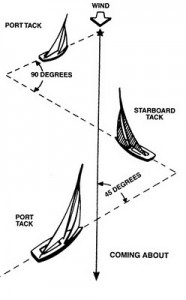 An article from Bill Gladstone of North U on the US Sailing site.
An article from Bill Gladstone of North U on the US Sailing site.
As mundane as they may seem, good tacks are essential to good racing. Make each tack a little better and you’ll save a few boat lengths every race.
Tacks can be divided into two parts: The Turn, and The Acceleration. Surprisingly, after The Turn you are ahead in VMG of where you would have been had you not tacked. All the losses due to tacking accrue during the critical second part – The Acceleration.
We’ll look at “The Turn” this week…
We are always ready to tack. Unless we’re on the layline, as we complete one tack the expected next maneuver is another tack. As soon as one tack is complete we prepare for the next one.
At “Ready About” do nothing, or at least, as little as possible. If hiked and sitting out board then one crew may need to turn inboard, but is it slow to have the entire crew turn in and stop hiking at “Ready About.” This slows the boat going into the tack and the penalty compounds throughout the tack. At “Ready About” you should hike harder as one crew member turns in and prepares for the jib release. At the helm, do NOT wind up (by which I mean, do not bear off onto a close reach) in preparation for tacking. Just keep sailing close hauled.
Before tacking make sure you are not tacking into bad air, and look for a relatively smooth spot to turn in. At “Tacking” lean in to heel the boat into the tack. Now is the time to create weather helm to help the boat steer itself up into the wind with minimum rudder. You can also help by pulling the traveler up as the boat turns into the wind.
Use a smooth turn.
The idea is NOT to get from tack to tack as quickly as possible, but to carry as much speed from tack to tack as possible. Too fast a turn and you throw off speed; too slow and you lose momentum. Start with a slow, smooth turn. For a brief moment you will be going almost full speed almost straight upwind. Don’t fight that….
Release the jib as it luffs or backs half way across the foredeck. Too early a release and the jib blows out to leeward, making for a slow tack. Too late, and the jib backs against the rig like a huge air brake. Release just as the jib backs so it blows across the bow in one smooth motion.
Two more details: 1) NO Creep. Do not let the jib creep out before the release.
2) Full release: When you do release, let the jib run completely so the trimmer on the new side won’t be fighting the old sheet.
As the jib is released use a little quicker turn to get through the eye of the wind. Slow the turn as the jib crosses the rig and stop turning the helm before you are down to course. You do not need to turn the boat all the way through to the new close hauled course; the boat will finish the turn for you. You want to finish the turn a few degrees below your ultimate close hauled course. The lighter the breeze the lower you want to come out of the tack. Perhaps five degrees low of course in light air; three degrees low in moderate breeze; and right to course in heavy air.
Many skippers over steer the end of the turn and then correct back up. Ease through the end of the turn and let the boat finish the turn for you.
A big overlapping genoa at the top of its wind range can be a bear to trim out of tacks. The driver can help by slowing the turn just above close hauled to allow the trimmers to get nearly full trim before the jib loads up. The trimmers should be trimming hard with full wraps and the handle in place throughout the tack. Tail like crazy and grind to spin the drum and prevent over-rides when sheet load is light.
In waves or chop a quicker turn is needed, as momentum is lost faster. In waves you want to turn quickly enough so that the wave pushes the bow onto the new tack. Start your turn in a wave trough and turn so your bow passes through the waves as the bow pops up and out of the wave, such that the next wave pushes you onto the new tack. (If you cannot turn through the waves this way then you are sailing in chop….)
Meanwhile, the crew who has leaned in to create helm to start the tack should hike to the (old) windward side until the jib blows through and then spring to the (new) windward side to hike the boat flat as the sails fill on the new tack.
With the main eased a few inches and the jib trimmed a few inches short of full trim, the turn is complete.